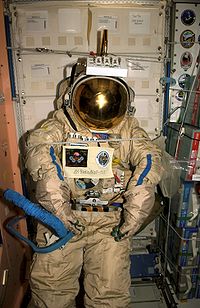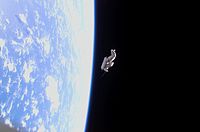SuitSat
SuitSat or Radioskaf ( Russian Радиоскаф ) is a satellite that was launched on February 3, 2006 UTC by the International Space Station . He was assigned OSCAR number 54; As AMSAT was significantly involved in the planning, the full OSCAR identifier is: AMSAT-OSCAR 54 ( AO-54 for short ).
It is actually “just” an old Russian “Orlan-M” space suit with blue stripes, which was equipped with three additional batteries, a transmitter, sensors and a handle. The suit came on 16 September 2001, together with the Pirs -Luftschleuse to the space station and was on three spacewalks used (in January 2002 by Yuri Onufrienko , in August 2002 by Valeri Korzun and 2003 by Michael Foale ).
The parts required for the conversion were brought to the station in September 2005 with the transport spaceship Progress M-54 and installed by the space travelers.
Course of the mission
SuitSat was launched during the second spacecraft activity of ISS Expedition 12 at 23:03 UTC on February 3, 2006. The two space travelers took the space suit into space and Valeri Tokarev pushed it off with the handle at waist height. A certain direction had to be followed. On the previous exit, a similar procedure was used to remove the Floating Potential Probe from the station.
The satellite, in the form of an old Russian "Orlan-M" spacesuit, was supposed to orbit the earth for about six weeks before it burns up in the atmosphere. It has been estimated that SuitSat will work for up to four days. The power supply came from the batteries in the spacesuit, supported by a few more in the added components. In order to extend their service life, the heating of the spacesuit should be switched off.
As an amateur radio satellite, the converted spacesuit sent a radio signal on the frequency 145.990 MHz. First an identifier was sent in English: "This is SuitSat-1, RS0RS", followed by greetings in five different languages and telemetry data. This information was sent in English. A speech synthesizer was built in for this. At the end of each transmission, an image should be broadcast via slow scan television . There was a competition to decipher this image.
The last confirmed receipt of the signal from SuitSat-1 was on February 18, 2006 at 6:36 am (UTC). Thus SuitSat-1 worked in orbit for 14 days, 7 hours and 34 minutes.
Trajectory
An interesting aspect of the mission is the trajectory of the old spacesuit. SuitSat was launched from the Russian lock Pirs . This points to the earth. The space suit was launched in the direction of flight backwards. It is assumed that the initial speed will be up to 60 cm / s. The spacesuit moved up to a distance of 300 m from the station and entered a lower orbit before slowly approaching the ISS again. It flew just below the space station and passed it. As it swiveled further into the new orbit, the spacesuit picked up speed and moved away from the station in the direction of flight. After orbiting the earth, SuitSat had a distance of 8 km, after one day this distance increased to at least 80 km. For a viewer from Earth, this corresponds to a distance of approximately 10 s.
As you orbit the earth further, the spacesuit will be slowed down more and will continue to move towards earth. The lower orbit also increases the speed at which it moves away from the station.
All other take-off directions could pose a threat to the International Space Station. A launch directly towards Earth or in the opposite direction would turn the suit into a satellite of the station. The reason for this is that the orbital speed of the space suit around the earth is the same as that of the station, since the start vector is perpendicular to the orbit direction of the space station.
A takeoff in the direction of flight would result in a slower and higher orbit. Since SuitSat is braked more strongly than the space station and would enter deeper, faster orbits, the two orbits would cross many times.
Downlink sequence
In order to increase the service life of SuitSat-1, a pause of 30 s was inserted between each voice message.
The sequence has the order
- SuitSat ID message (5 s)
- international voice messages
- Telemetry data or an SSTV image (15–45 s)
followed by a 30-second pause. Then the sequence starts over.
The international notification consists of
- Telemetry data (as voice message)
- Russian message
- "Europe Student Message" (Spanish and German)
- "Bauman Institute Message" (Russian)
- "Canada Student Message" (French)
- "Mr. Alexandrov Message "(English)
- "Japan Student Message" (Japanese)
- "USA Student Message" (English)
- SSTV image
Web links
- AMSAT: This Is SUITSAT-1 RS0RS !! (English) ( Memento from May 31, 2016 in the Internet Archive )
- NASA: SuitSat (English)
- AMSAT: SuitSat Readies for Operation on 145.990 MHz (English) ( Memento from March 2, 2016 in the Internet Archive )


